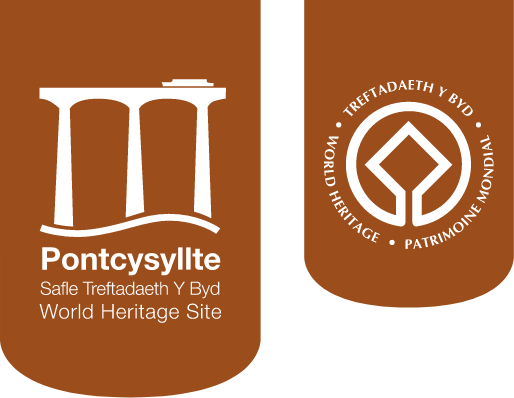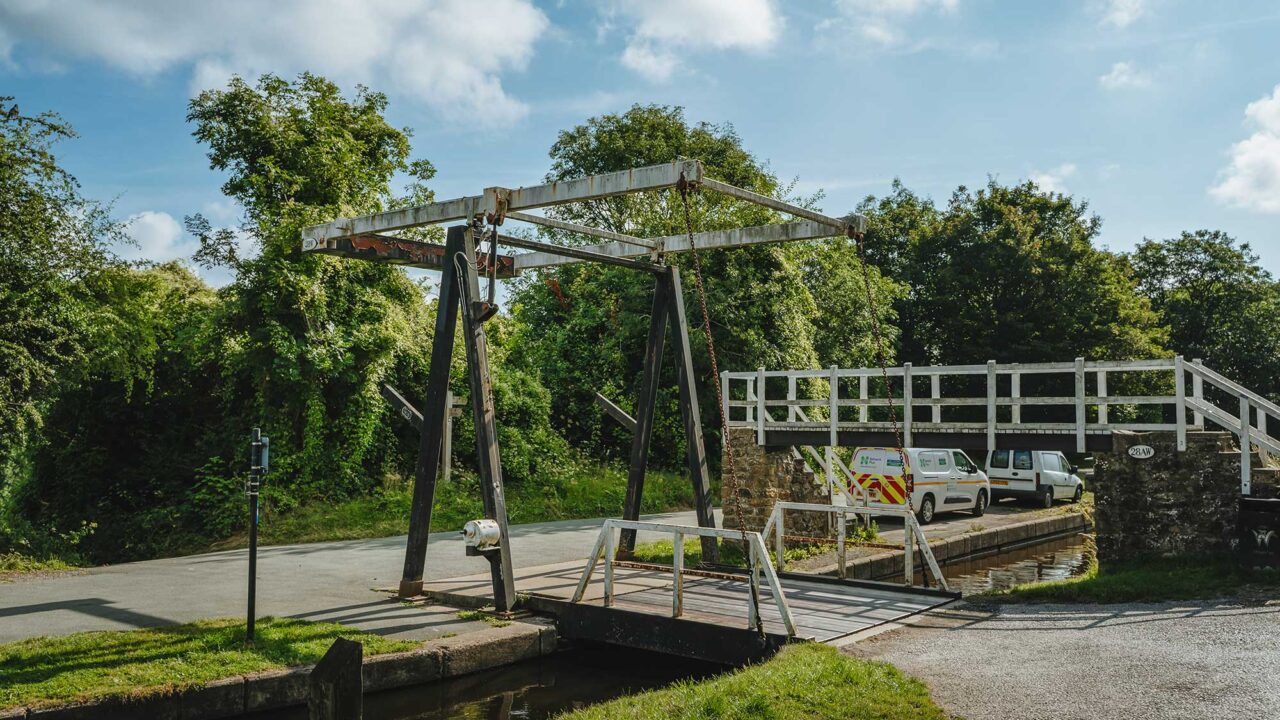Introduction
Froncysyllte, known locally as Fron, grew from a small rural hamlet with only about 15 houses and one inn to a hive of industrial activity after the canal opened. New houses, shops, church, chapels and a school were built while men left their work in the fields to work in the local limestone quarries and limekilns as well as the nearby coalmines and brickworks.
By the beginning of the 1900s there were over 900 people living in the Fron area. Gradually these industries came to an end and today just glimpses of the former works can be seen. This tour will give you an insight into how the village has changed and introduce you to some of the remarkable people who lived here.
Click on any Point of Interest marker to view the description
1. Irish Bridge & Wharf
Irish Bridge may have been named after the ‘navvies’, or ‘navigators’, who dug out numerous canal systems. Many of the navvies came from Ireland in search of work, as canal and road building thrived in the late 1700s and early 1800s.
The arch of this bridge is much higher than others on the canal as this is such a deep cutting. Spoil from the cutting was used to create the embankment for Pontcysyllte Aqueduct.
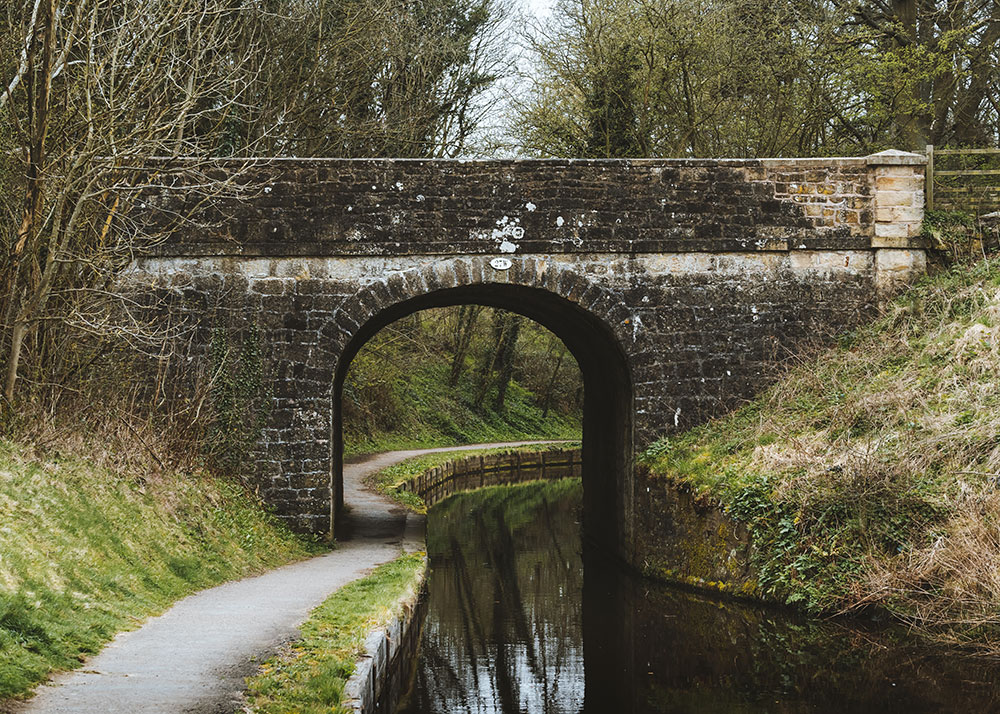
Irish Bridge
The flat area just beyond the bend was a wharf, originally used to unload limestone from Froncysyllte.
The Pen-y-bont brick works was established in 1865, making use of a substantial clay pit on the site with its distinctive vibrant ‘Ruabon red’ colour. A tramroad ran from the works to a wharf on the flat area just beyond the bend of the canal. By 1881 this had been superseded by a standard gauge branch from the works to the Great Western Railway.
James Coster Edwards, who developed the works, produced a vast array of high quality bricks, roof and ridge tiles and chimney pots. However it was his pioneering use of large scale decorative red terracotta used as ornamental material on many of buildings for which he became well known. Even the Pen-y-bont main office is a showpiece which exhibits the beauty of the work that the company produced. The works was sold in 1956 and closed in 1960.
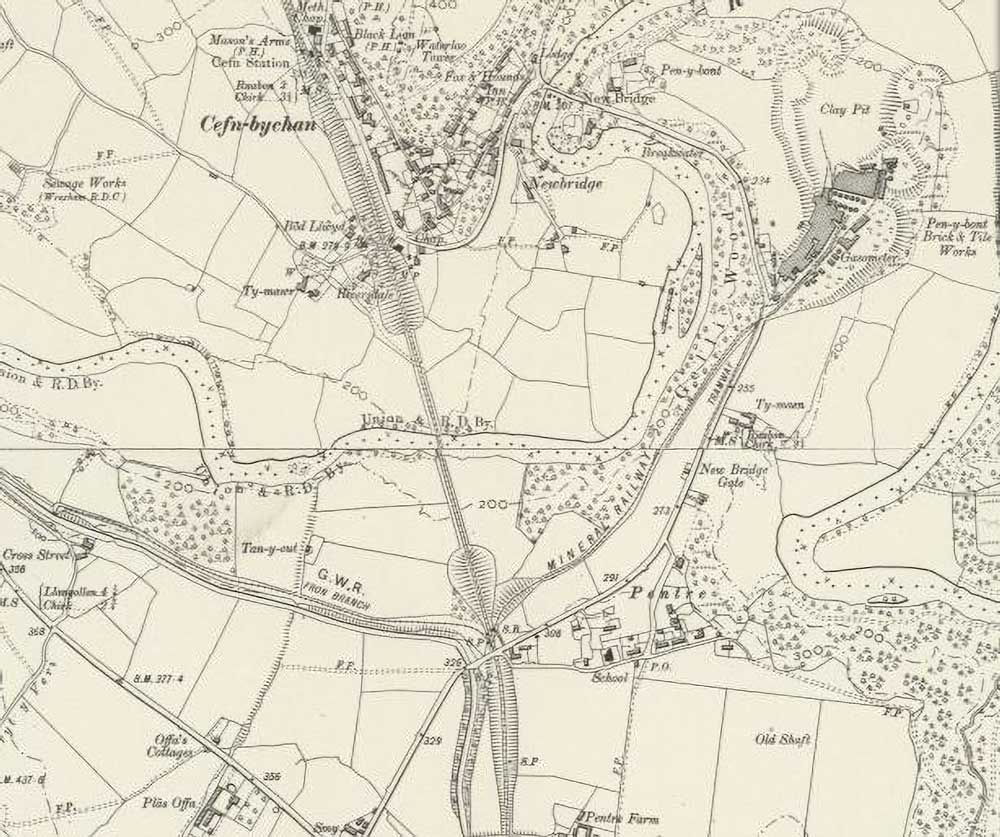
OS Map 1888 showing Penybont Works © By permission of The National Library of Wales
2. Cross Street Aqueduct
Cross Street Aqueduct carries the canal over a farm track as it was easier to take the canal over the track than build a bridge to take the road over the canal. It was built using traditional stonework and puddled clay to make a watertight lining in the canal. This method of construction is suitable for small aqueducts but too unstable and too expensive for larger aqueducts with several spans at great heights.
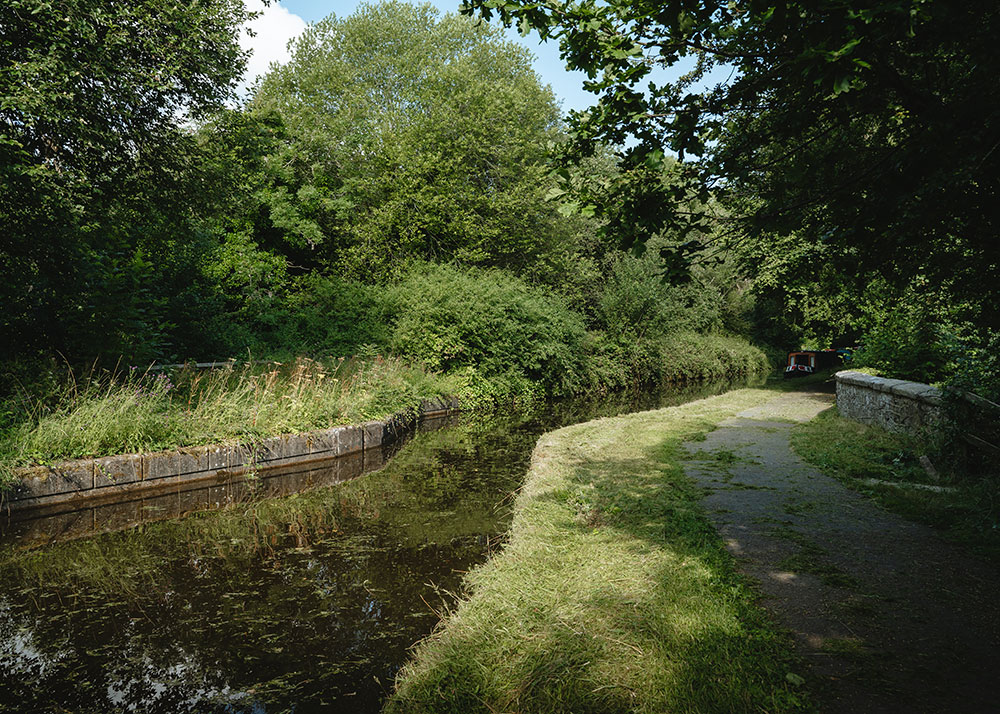
A horse-drawn tramway from the limekilns at Froncysyllte went under the canal here to join the main railway line at Irish Bridge. You can still see the remains of the crossing point turntable which was positioned at ninety degrees to turn the wagons around the tight corners.
It is easy to miss the aqueduct when you are walking along the canal but there is a viewpoint at the bottom of the embankment.
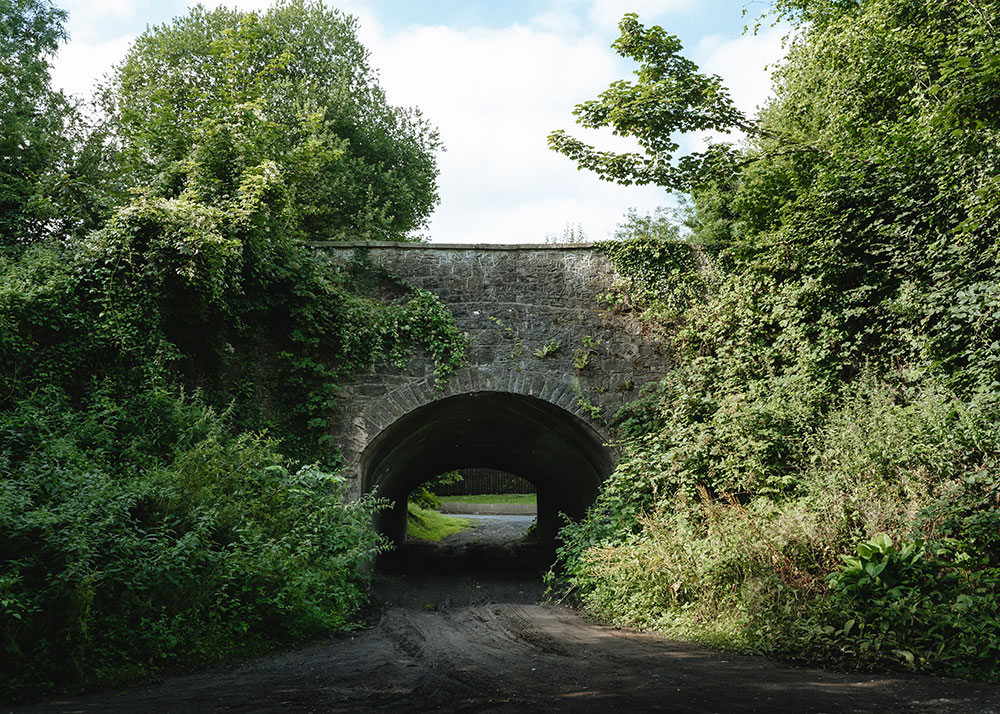
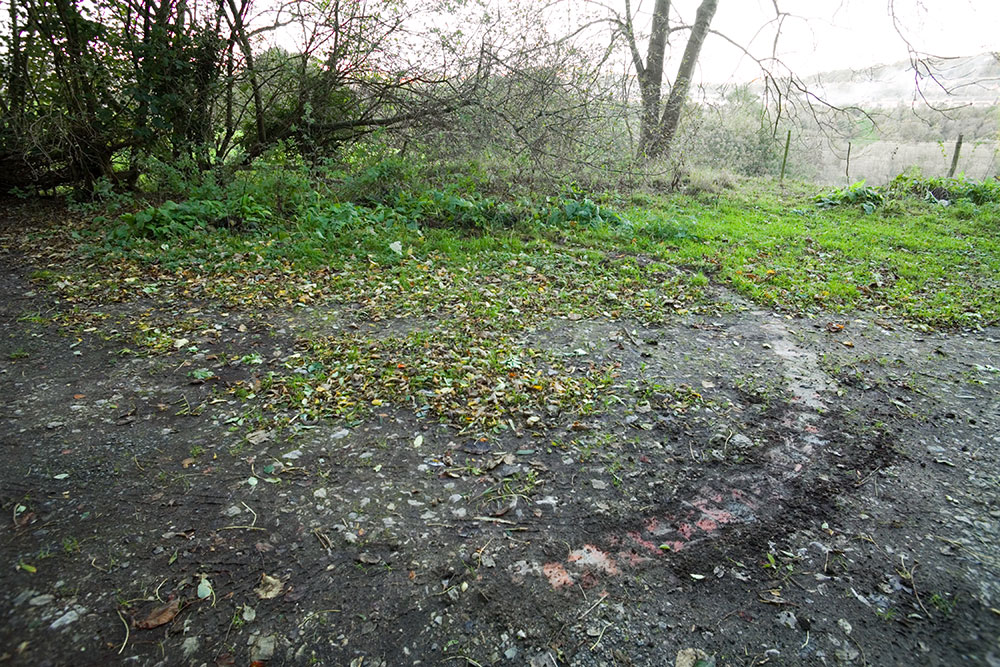
Remains of turntable © Crown copyright: RCAHMW
3. Fron Limekilns
Limestone has been burned to make quicklime since Roman times. Most of this quicklime was then ‘slaked’ or mixed with water to make hydrated lime, the basis of lime wash and lime mortar. Demand for lime to sweeten the soil grew during the industrial revolution as farmers were under more pressure to feed the growing numbers of factory workers. Limestone was also in great demand for the production of iron, housing for the workers and road building.
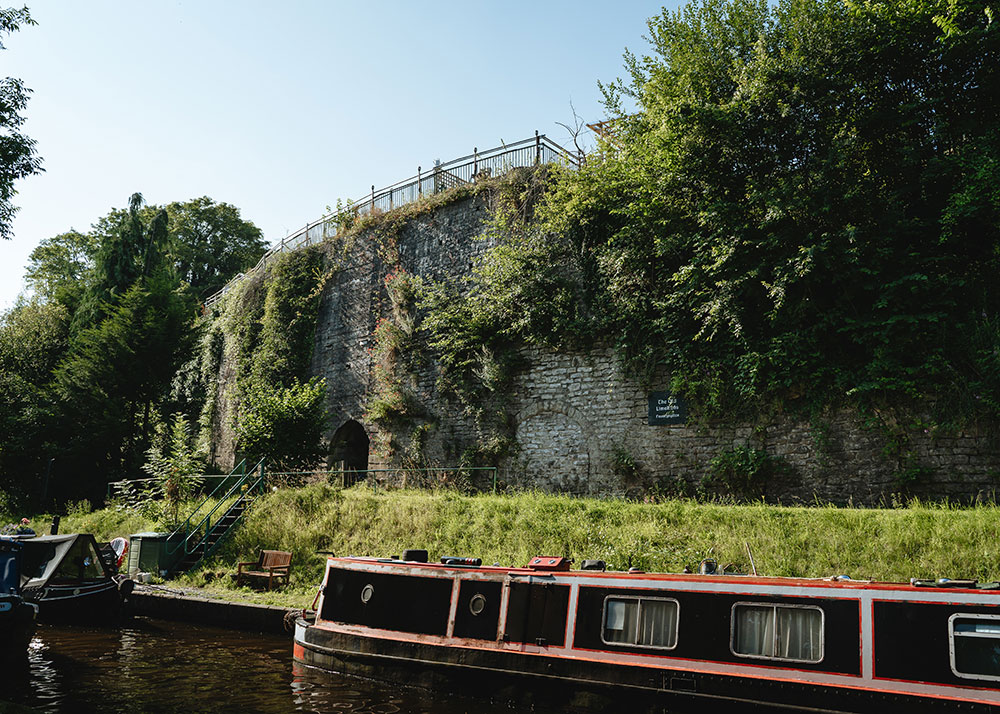
Froncysyllte East Limekilns
Although small scale limestone quarrying had taken place in the Froncysyllte area since the 1500s, the arrival of the canal at Froncysyllte provided cheap, efficient transport for limestone and lime products to reach new markets.
The smaller limekilns, the Froncysyllte west limekilns, were constructed in the early 1800s. They were owned by the great ironmaster William Hazeldine and connected by a steep tram road to Pisgah Quarry. There are two low kilns, with two arches facing the canal which were probably built as a single unit. There was also a wharf here to load up the lime on to the boats. They were known as Biddulph’s limekilns in 1822 when Thomas Telford improved the London to Holyhead Road running through the village.
The kilns are shown as working on the 1843 tithe map but were disused by 1899.
The imposing stonewall with six arches towering above the canal is the Froncysyllte east limekilns, built in the late 1800s. The limestone for these kilns came from Pen-y-graig Quarry above the village along a series of horse/donkey drawn tram roads.
The ruins of the limekilns today are in sharp contrast to what you would have seen a hundred years ago.
Life for a lime burner, such as Joseph Edwards who lived nearby, was very hard. He would have probably worked a 12 hour shift in hot, exhausting and dangerous conditions. The limestone was burned in kilns at 1000°C and gave off poisonous fumes so lime burners could lose consciousness and collapse. The lime powder had to be plunged in water to neutralise it, resulting in violent spitting that could cause serious burns to a worker.
One old expression associated with lime burners was ‘I’m as dry as a lime burner’s clog’, referring to the clogs that would split because of the intense heat of the kiln pit.
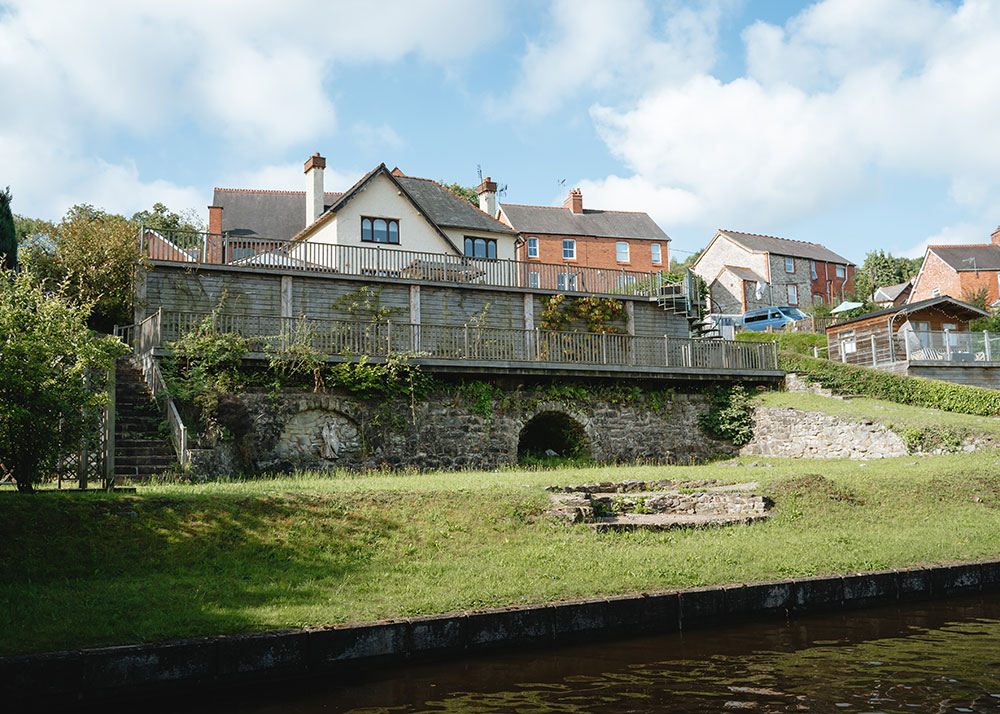
Froncysyllte West Limekilns
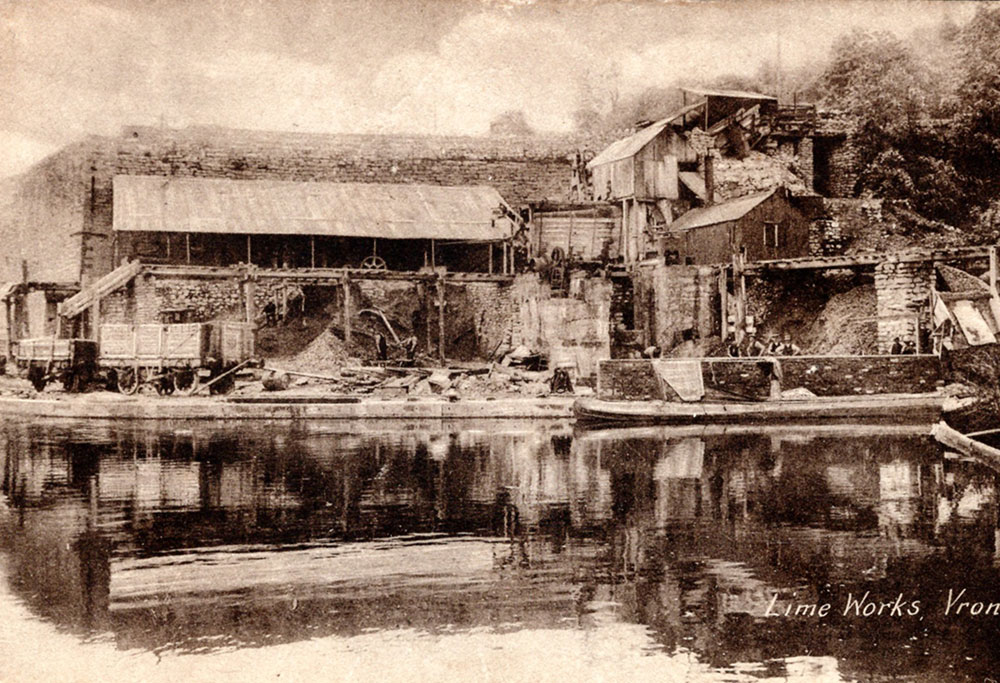
© Courtesy of Neil Hayward
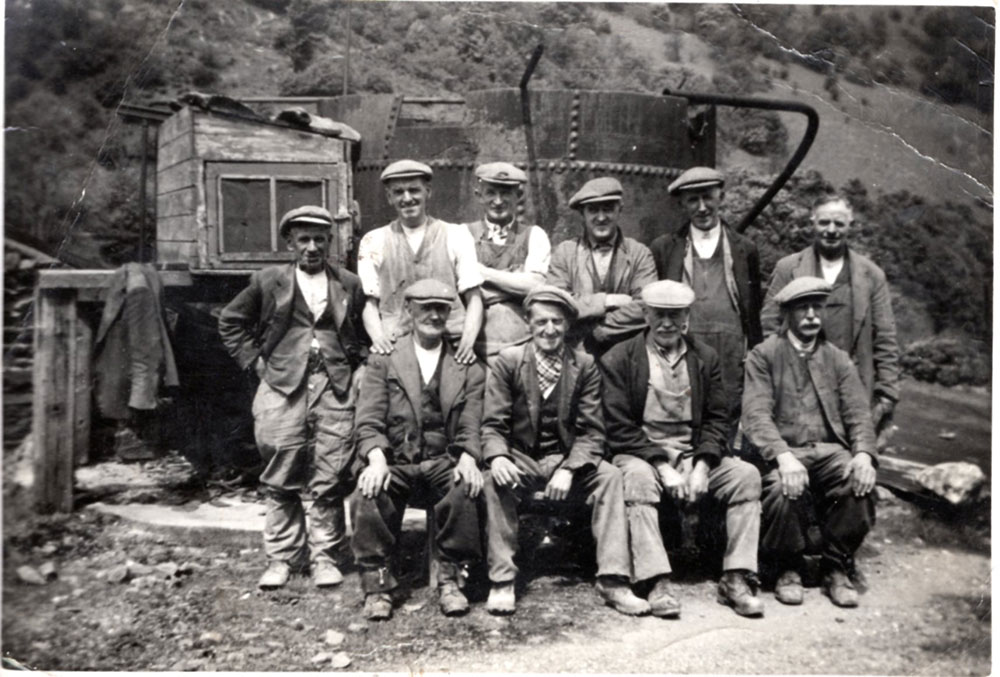
© Courtesy of Neil Hayward
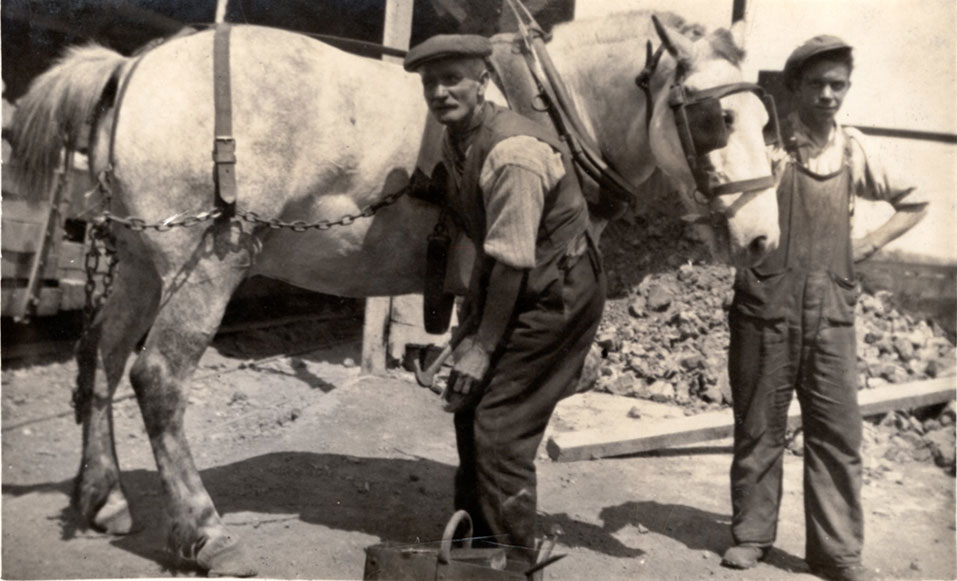
Blacksmith shoeing a horse at the lime works © Courtesy of Neil Hayward
4. Inclines and Quarries
A complex system of tramroads and inclines developed to bring the limestone from the Pisgah and Pen-y-graig quarries to the limekilns. Their development can be traced through the various editions of the OS maps of the quarry and the village.
The route to Pisgah Quarry was up a steep slope where the houses on Woodlands Grove now line the route. At the top of the steep incline the tram road turned towards the quarry along a road known as Greenfields and then led to the quarry. Pisgah Quarry ceased work in the 1890s and is now a North Wales Wildlife Trust reserve with spectacular views over the Vale of Llangollen.
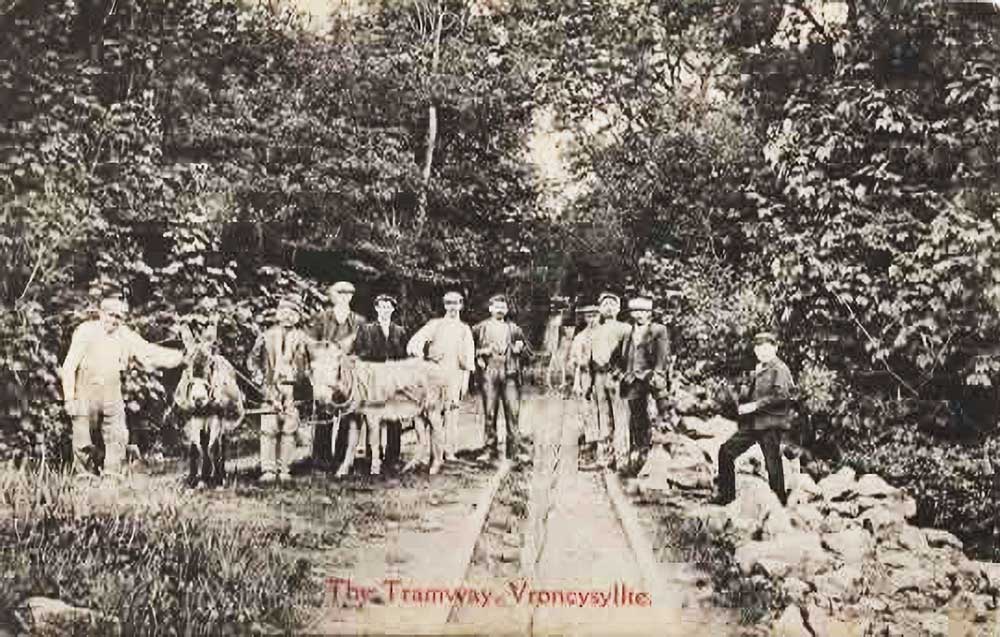
The Tramway at Froncysyllte © Courtesy of Neil Hayward
It was agreed to convert the old tramway on Woodland Grove into an ordinary road when Pisgah Quarry closed. Older people would still refer to Woodland Grove as ‘The Rails’. The developer was also given permission to get stone from the old quarry to build the road. The earliest houses you can see are Bourne Terrace, a group of red brick houses built after 1912 when the tramlines were covered over.
The route up to Pen-y-graig Quarry has also been made into a road in places. However a steep incline can be seen beyond the village beneath Woodlands Road at the turn off to the quarry. The quarry was in operation until 1954 but is now overgrown, with few remains visible from a nearby public footpath.
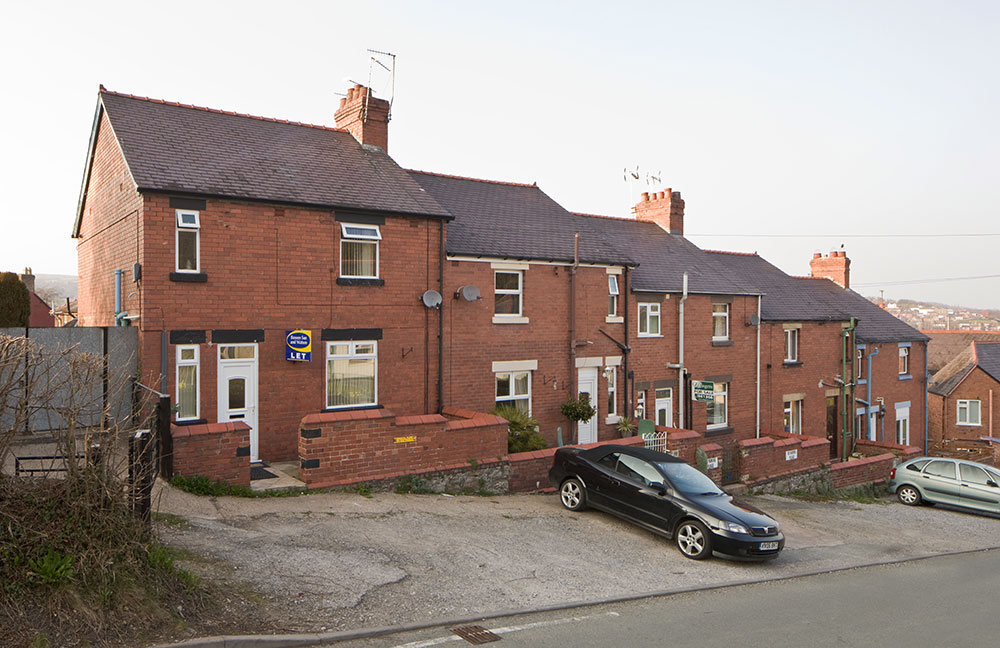
Woodlands Grove © Crown copyright: RCAHMW
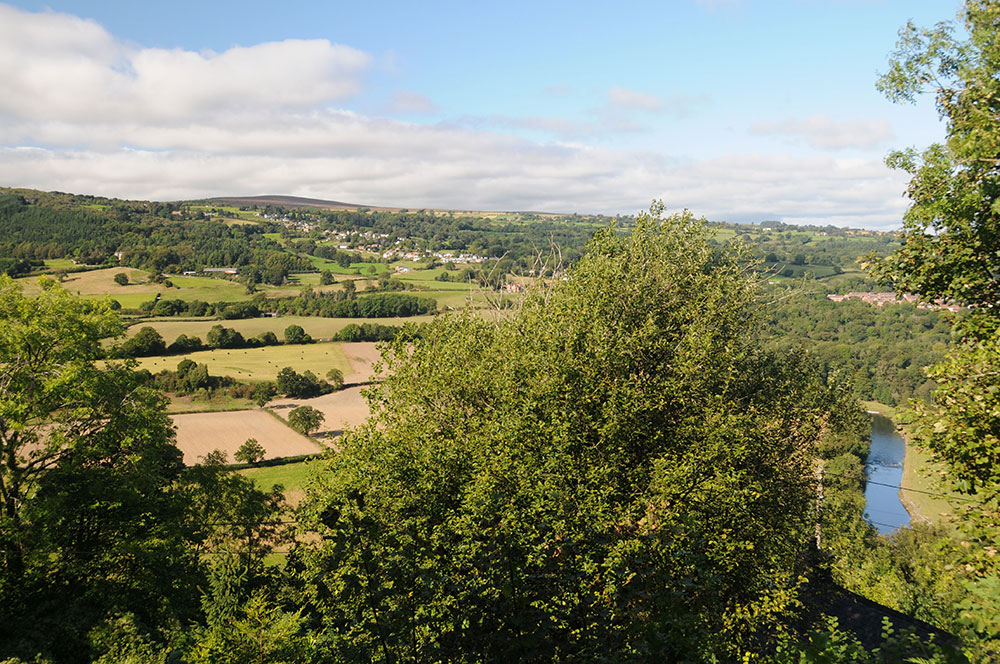
© Jo Danson
5. Fron Lift Bridge
This iconic lift bridge was a more convenient way of allowing horses and carts to cross the canal than a conventional humpback bridge as it took up less space.
The original timber bridge was operated by hand, pulling a chain to lift the deck. The current bridge is built to the same traditional design but is made from steel and the lift uses hydraulic power. The tall frame supports a counterbalance beam to lift the deck so that it moves smoothly from a horizontal to vertical position to allow narrow boats to pass through.
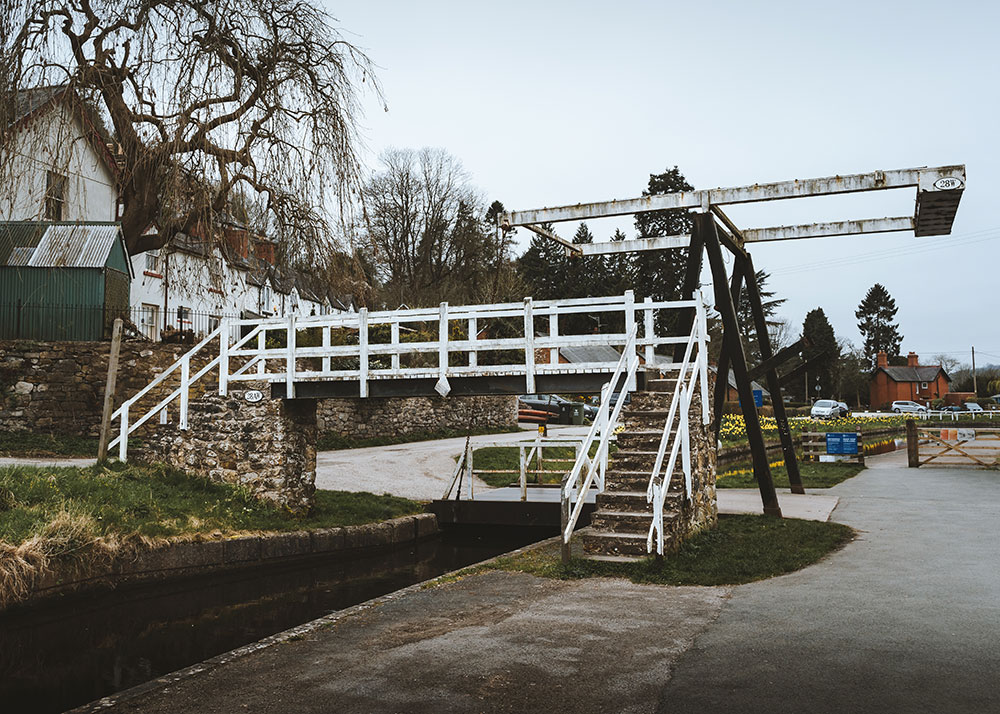
The footbridge was built in the mid 1900s.
Across the fields is a stunning view of the Pontcysyllte Aqueduct crossing the Dee valley, where you can begin to appreciate why it is called the ‘stream in the sky’.
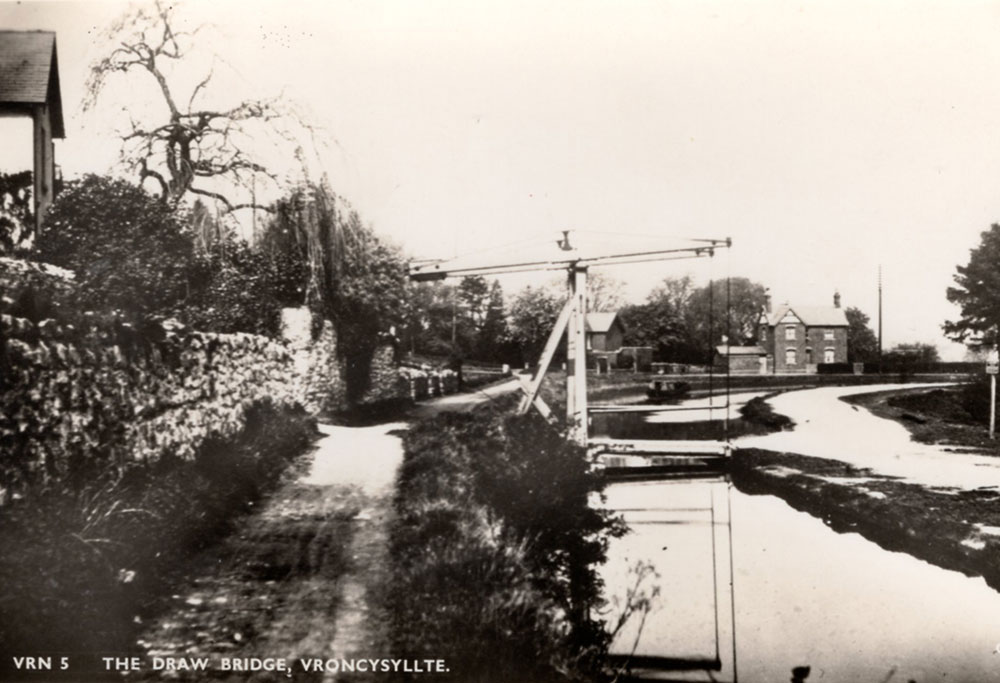
© Courtesy of Neil Hayward
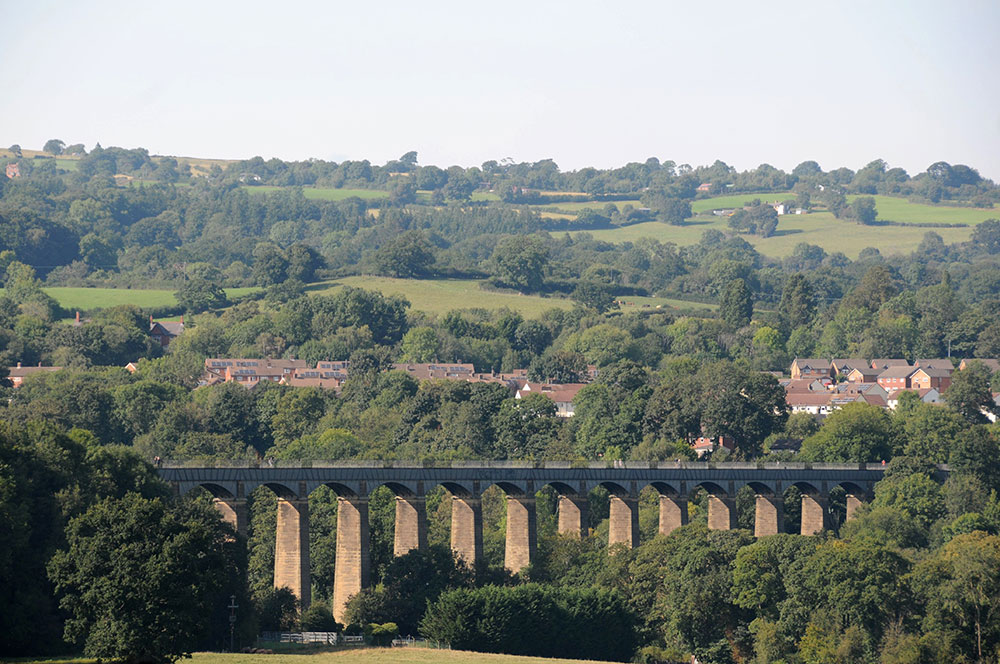
© Jo Danson
6. Fron Basin
Fron Basin marked the end of the Llangollen Canal until the Pontcysyllte Aqueduct was completed in 1805. Boats could turn in this area by putting the front of the vessel into the corner while the back of the boat was pulled around with a rope. Once the aqueduct was completed boats waited here to cross.
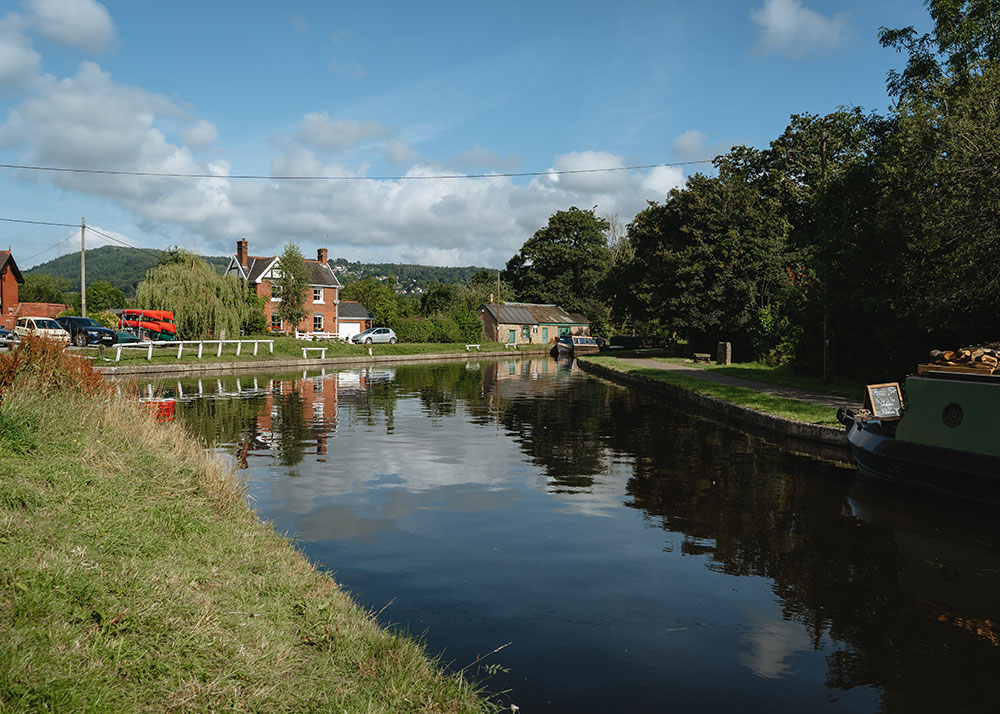
The open area alongside the basin was a public wharf for general trade, conveniently close to the major route of the Holyhead road.
You can see that when the basin froze in a harsh winter of 1906 children enjoyed skating on the water. It must have been thick ice for them to risk doing that!
Canal House was built in striking red brick in the late 1800s by the Shropshire Union Railway and Canal Company for a lengthsman and his family. Lengthsmen were responsible for a length of towpath, repairing and maintaining the banks of the canals, cutting back vegetation and treading puddled clay into sections of the canal bank that were weak or leaking.
The Canal Company looked after the welfare of their employees too. The stone mess building was built for maintenance workers to eat and socialise while the institute was used to provide some education for the children of the canal workers.
On the opposite side of the canal you can see the remains of a tramway and part of a wagon, now part of a sculpture by Anthony Lysycia.
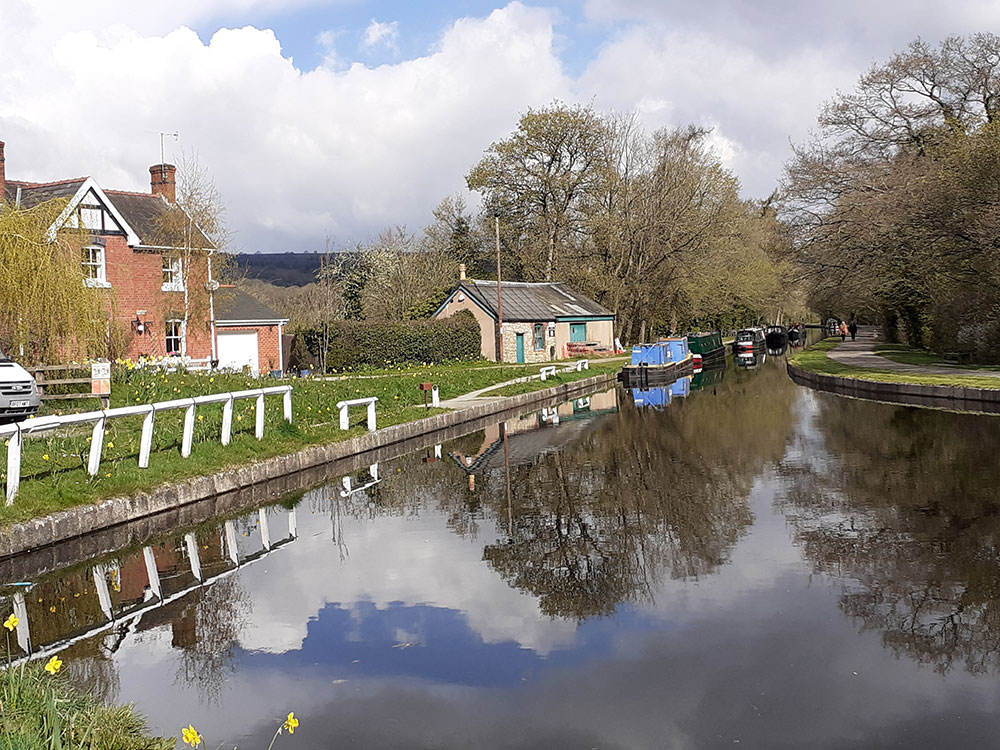
© Heather Williams
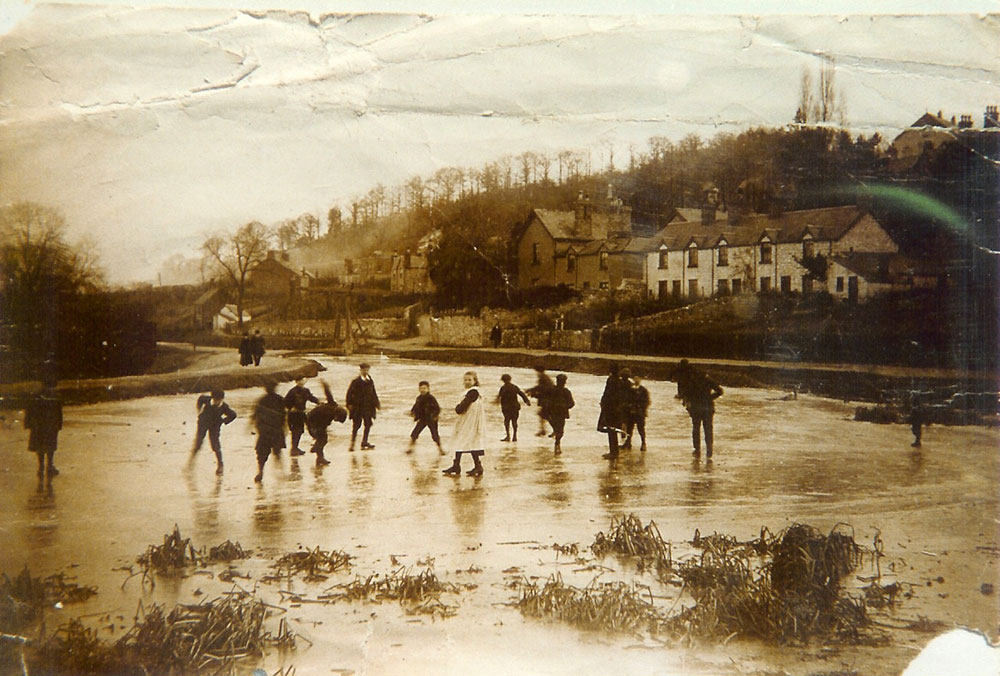
Frozen Canal at Froncysyllte, 1906: Courtesy of Julie Williams
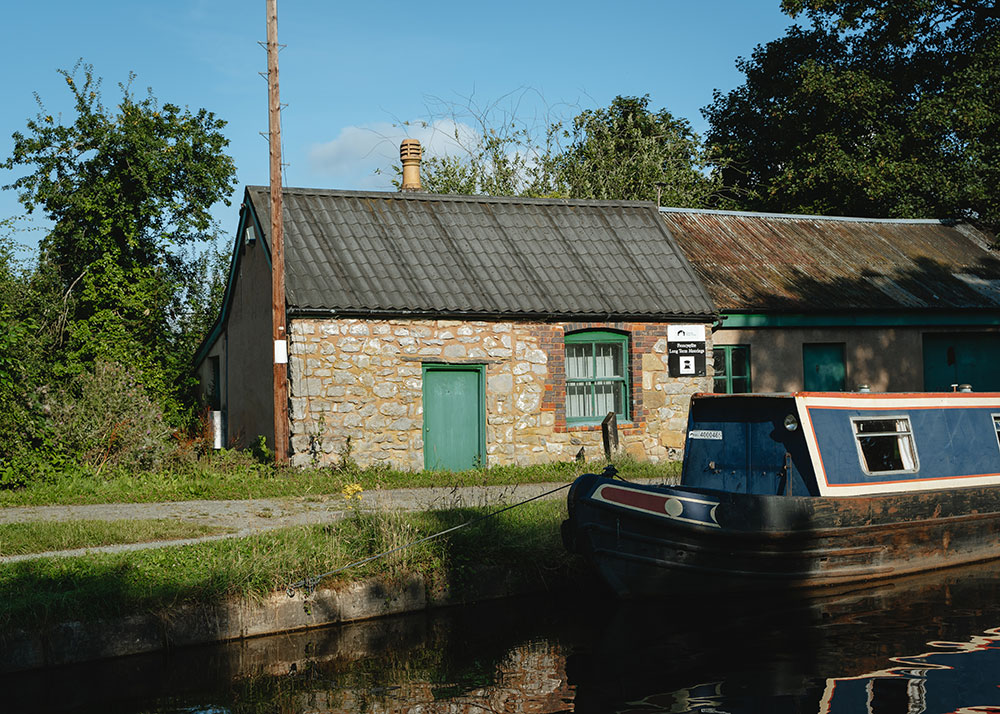
Mess & Institute
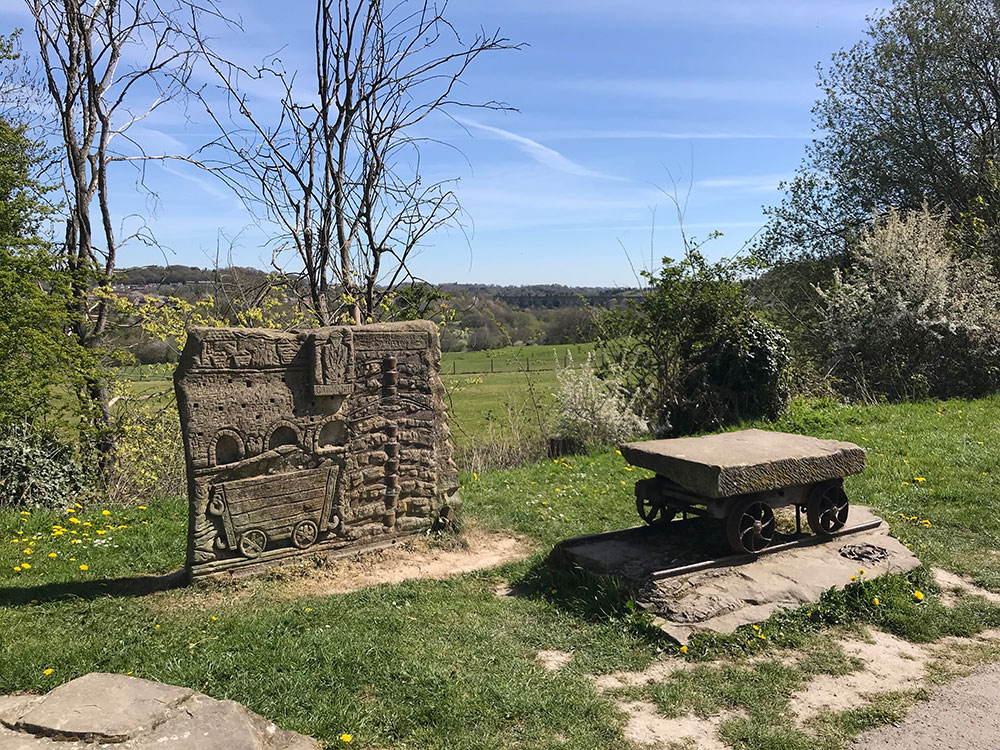
Lime Industry sculpture by Anthony Lysicea © Jo Danson
7. Argoed Hall
The impressive Argoed Hall was once the home of Robert Ferdinand Graesser who played a key role in the industrial development of this area when he established a chemical works in Cefn Mawr to extract paraffin oil and wax from local shale.
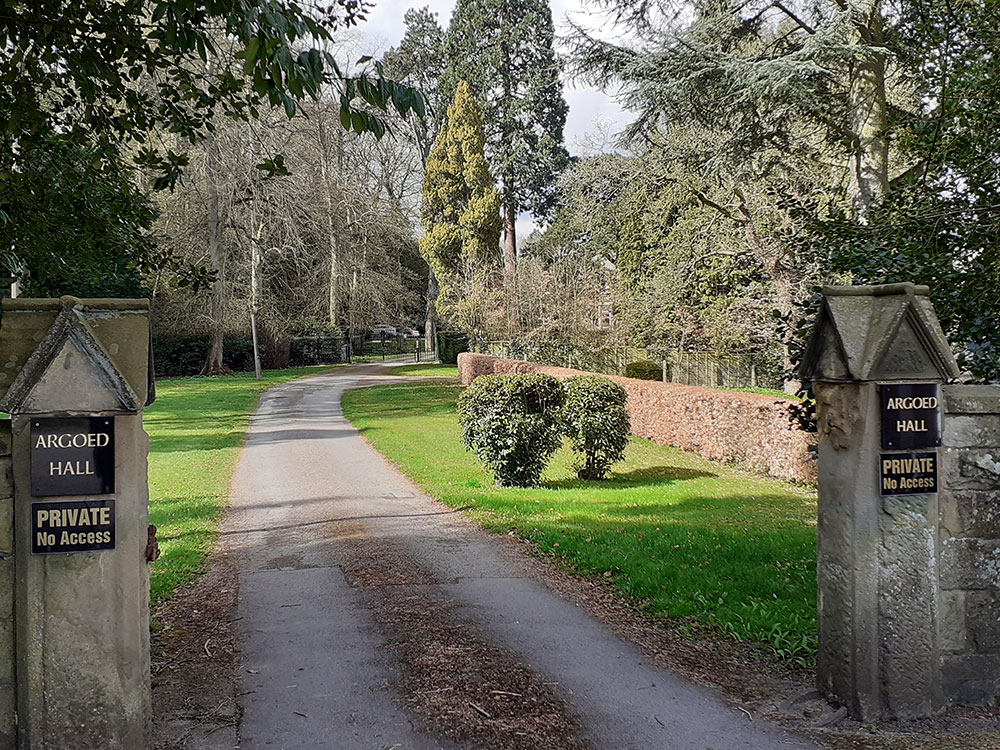
© Heather Williams
Graesser was from Germany and not allowed to own property until he became a British citizen in the 1870s. He bought Argoed Hall and the surrounding land in 1880 for the sum of £3,750. By 1880 his works were producing coal tar and carbolic acid or phenol, and became the world’s leading producer of phenol.
Graesser came to the rescue of Wrexham Lager, established by two other German entrepreneurs, when the brewery faced liquidation in the early 1890s, only a few years after being founded. He turned the business round to make it very successful by exporting the lager around the world, as far as Australia.
Argoed Hall was altered extensively in the late 1800s to provide a comfortable home for Graesser’s expanding family and servants with 11 people in residence in 1891. In spite of his busy business life, he still found time to join Richard Roberts to fish for salmon in a coracle on the River Dee.
On 15 July 1911 Robert Graesser walked from Argoed Hall to his chemical works where he collapsed and died at his desk. There was so much respect for the 66 year old that a crowd lined the road as his funeral procession made its way along the main road to St David’s Church.
Norman Graesser took over the family home and business, developing a partnership with the USA chemical company Monsanto in 1919. Nine years later Monsanto took full ownership of the company. After the family sold the Hall in the mid 1900s it became a home for the elderly and was later divided up into apartments.
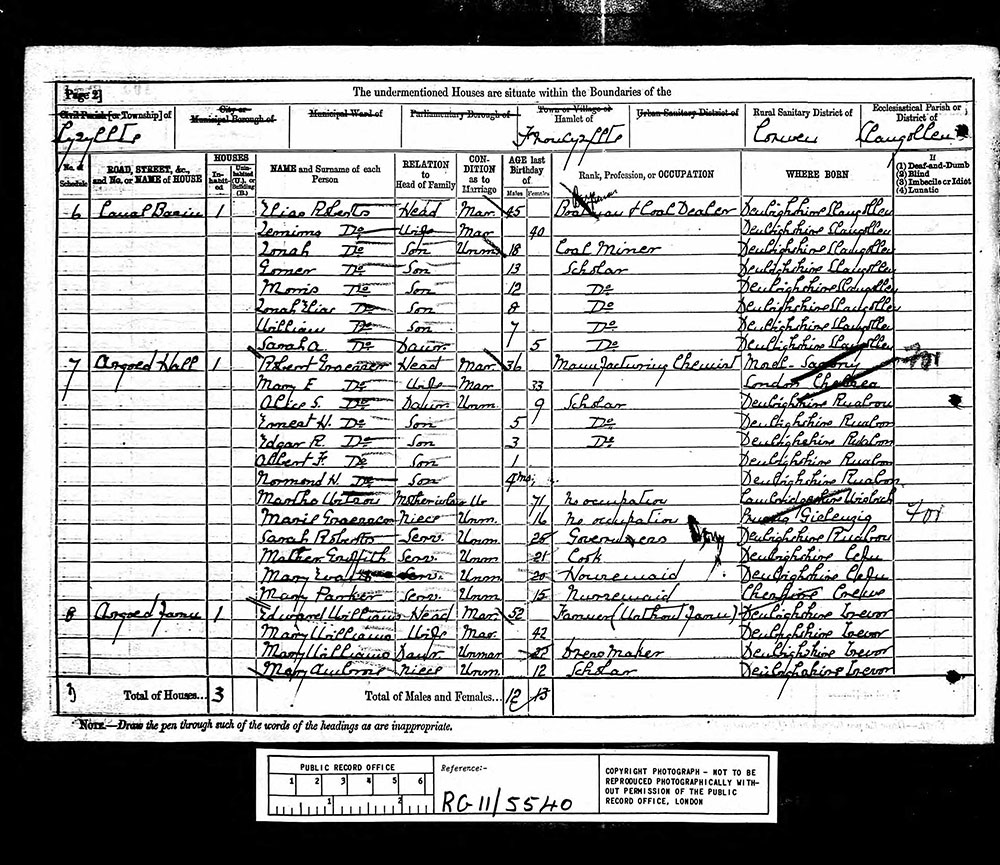
Argoed Hall 1881 census © The National Archive Crown Copyright 1881
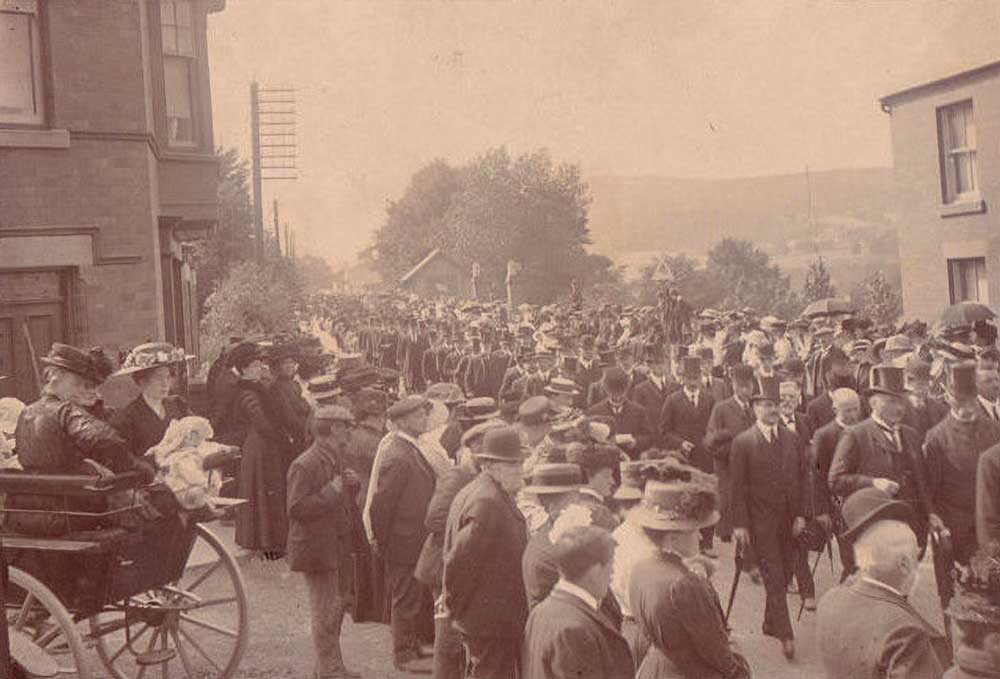
Funeral of Robert Gresser, 1911: Courtesy of Julie Williams
8. Fron House
Attractive Fron House has been the home to several locally influential people. Walter Eddy, an experienced mine engineer from Cornwall, came to live here in the early 1830s as the coal mining industry was growing. At first he lodged at Cysyllte Farm with John Edwards, a prominent Welsh Baptist, farmer and the village undertaker.
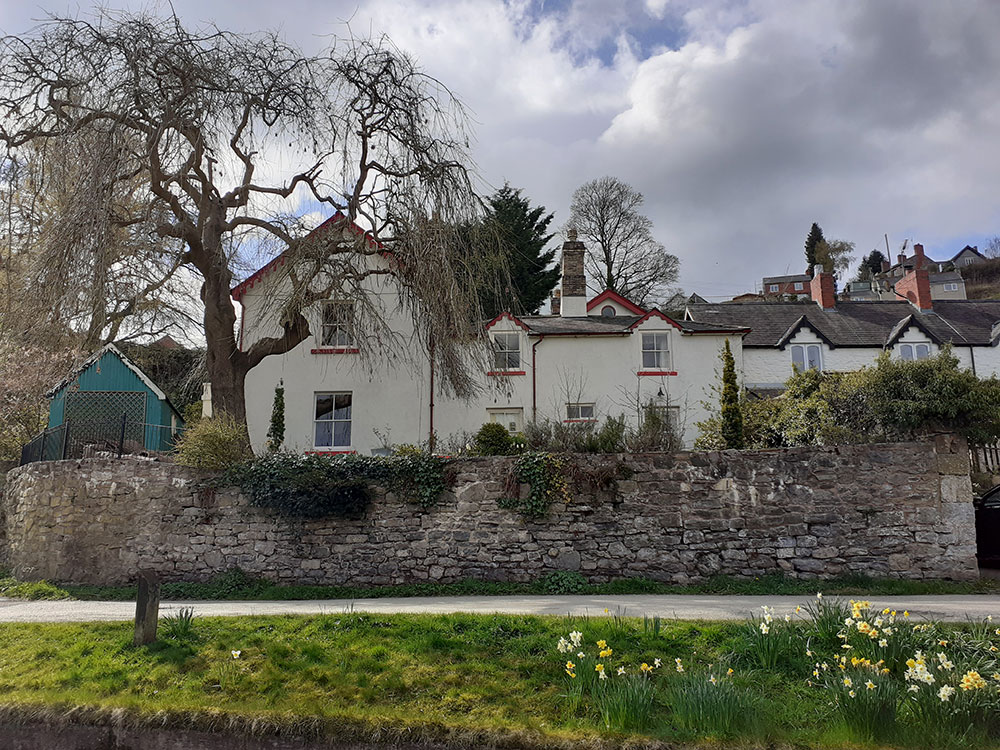
© Heather Williams
By 1851 Walter Eddy had bought this house and started to convert it into a fine gentleman’s residence that he later named Fron House. Eddy became a mining engineer for the limestone quarries in Froncysyllte and eventually was managing director of the company.
Eddy made a huge contribution village life. He was a loyal churchman and it is thought he played a key role in the provision of land for St David’s Church which opened in 1871 as a combined school and chapel. The beautiful stained glass window, installed after his death in 1896, was paid for by public subscription and shows how well thought of he was in the village.
Fron House remained in the family and in 1932 Eddy’s granddaughter, Dorothy Hartley, moved here. Dorothy was an art teacher and generously gave free art lessons to the villagers at her home. However she was best known as a writer and her most popular book, written and illustrated by her, was ‘Food in England’. It included many old traditional recipes combined with anecdotal stories and household hints, some of which dated back to medieval times. After it was published in 1954 it soon became a ‘bible’ for cooks and had a deep influence on contemporary cooks and food writers. Appropriately her simple gravestone in St David’s churchyard is an open book with her name and her occupations as writer, artist and historian.
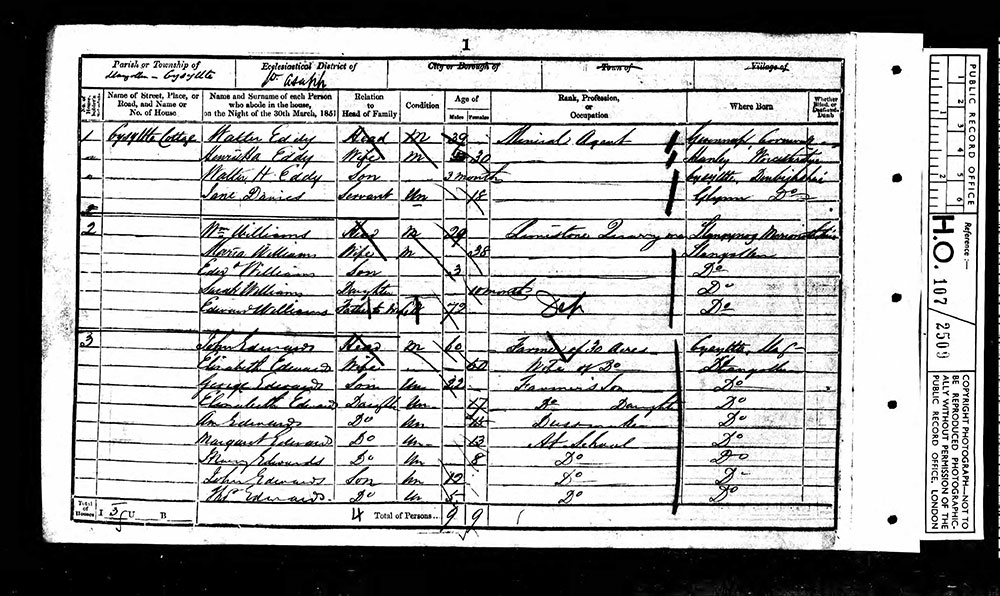
Walter Eddy, 1851 census © The National Archive Crown Copyright 1851
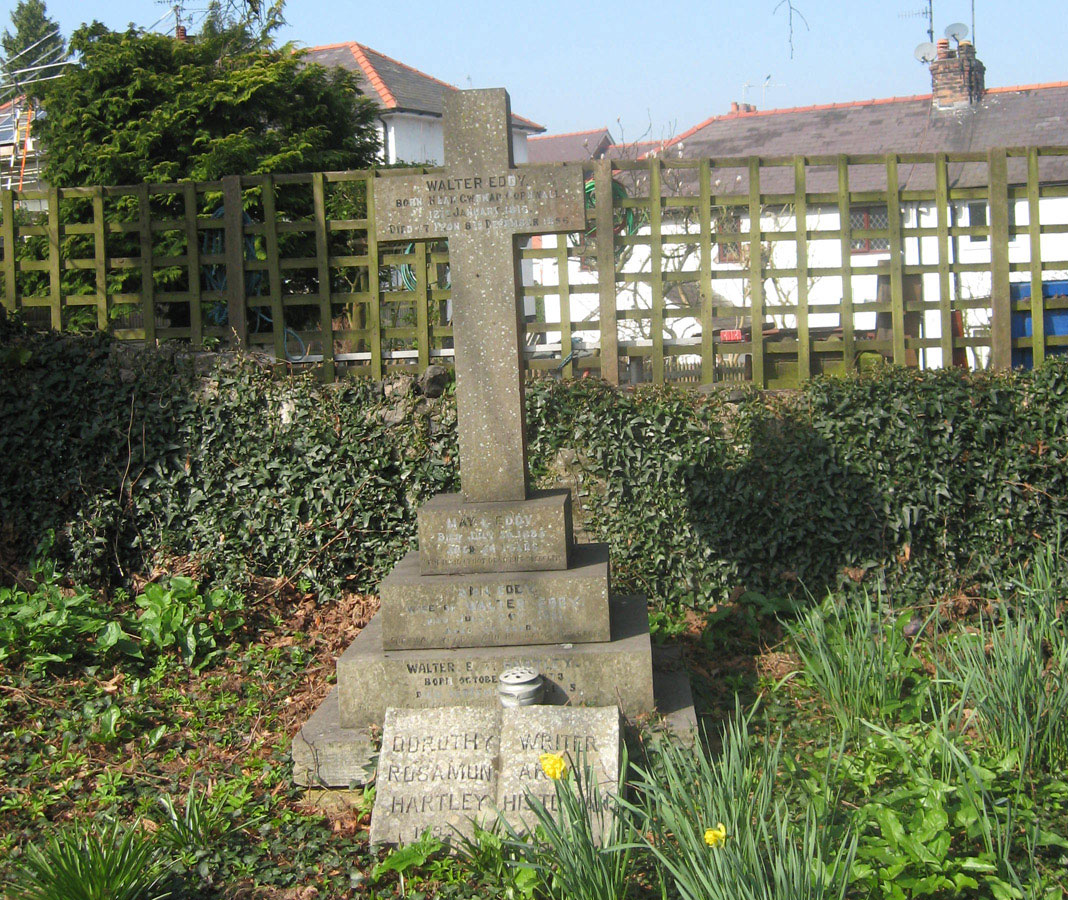
Courtesy of Julie Williams
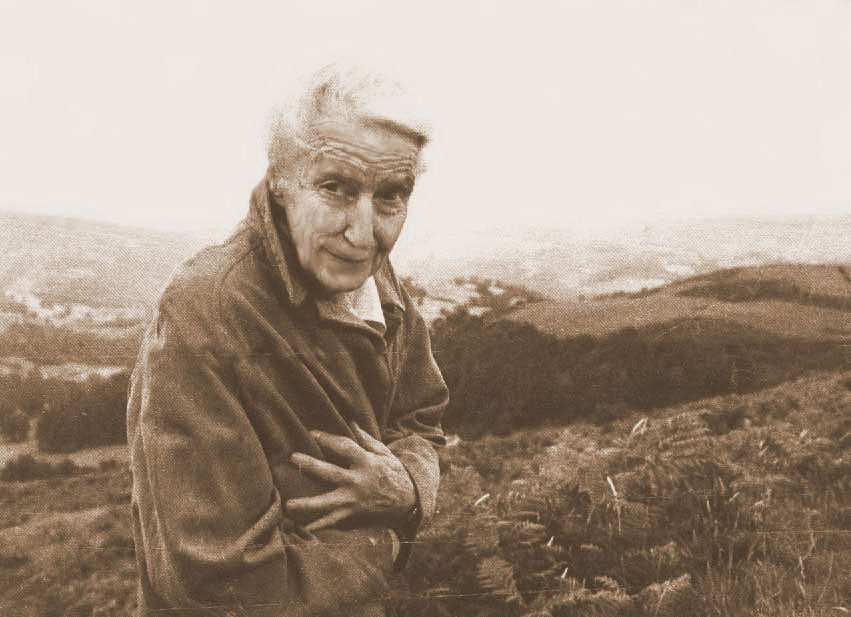
Courtesy of Julie Williams
9. Aqueduct Inn
The Aqueduct Inn was a former coaching inn, built before the Aqueduct. At one time it was grandly called the Aqueduct Hotel. There was an enclosed yard with a sign advertising good stabling available for customers’ horses. Inquests and auctions were held here in the 1800s which probably provided welcome additional income for the landlords.
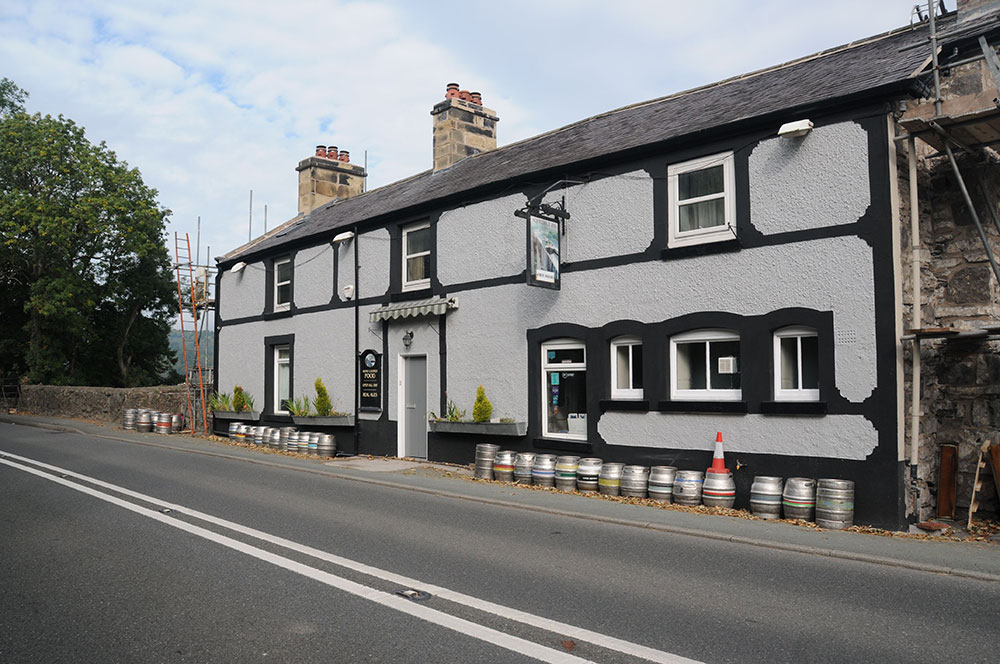
© Jo Danson
Unfortunately some landlords were tempted to drink rather too much! Edward Jones, a landlord here in 1874, admitted to being drunk and incapable of attending to his business. Another landlord, Jonah Griffiths, also had a drink problem, which led to the pub licence being transferred to his wife Ann. In 1906, while affected by the after effects of alcoholism, he cut his throat with a razor. Two years later, after attacking his wife, he agreed to treatment at a home for alcoholics.
At this time, the Sunday Closing Act banned drinking alcohol on Sundays in Wales, except for people on long journeys. Two men, Arthur Thomas and William Thomas, were fined for drinking at the Inn on Sunday 31 July 1910 when it was discovered they had only travelled one mile to have a drink!
From the Aqueduct Inn you have a bird’s eye view over the Froncysyllte Basin and the canal making its way towards the Pontcysyllte Aqueduct while opposite is Cefn Mawr, meaning Big Ridge.
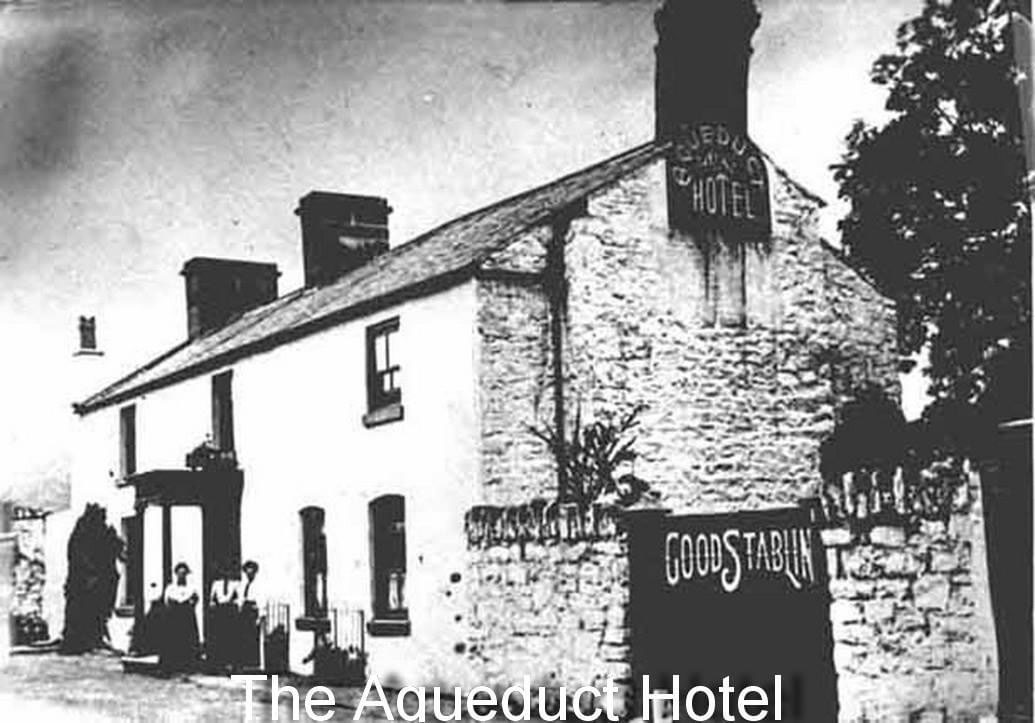
© Dennis Williams
10. Froncysyllte Chapels
As the village grew in the 1800s so did the number of chapels. Froncysyllte reflected what was happening nationally with the villagers embracing non-conformism and the need for some chapels to provide services in Welsh.
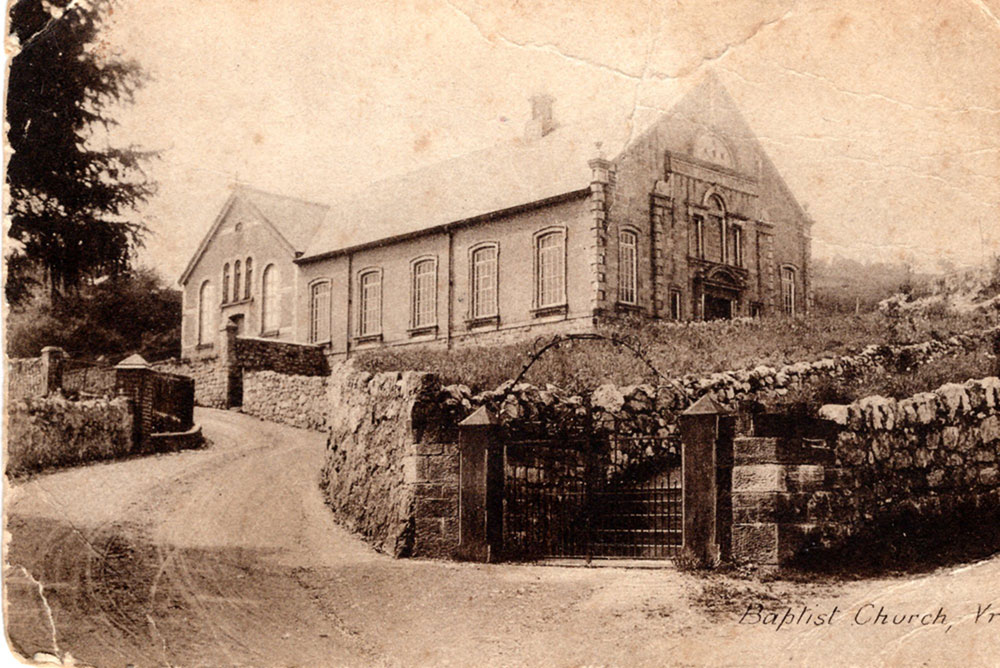
Carmel Chapel © Courtesey of Neil Hayward
Carmel Chapel was the first, built by the Baptists on Carmel Terrace in 1844. It was replaced by a massive chapel in Woodlands Road as the congregation increased. However it closed in 1988 and was later demolished.
Mount Zion Chapel was built by the Primitive Methodists in 1858, but was replaced in 1914 by a new red brick chapel on the A5 road. This has since been converted to an Auction House which is a prominent feature on the main road. The original stone chapel was converted for use as a school room and is now the canteen of Froncysyllte School. It is considered to be a good early example of a traditional non-conformist church in the area, with its ‘gable entry’ form of architecture.
A Wesleyan Methodist Chapel was built in 1860, and rebuilt in 1871 on what became known as Methodist Hill. By 2003 this had been converted into residential use.
The Independents, later known as the Congregationists, built Capel Seion in 1851 and then renewed the chapel in 1881 as its congregation grew. It was here that a public meeting was held in 1947 to discuss establishing a male voice choir.
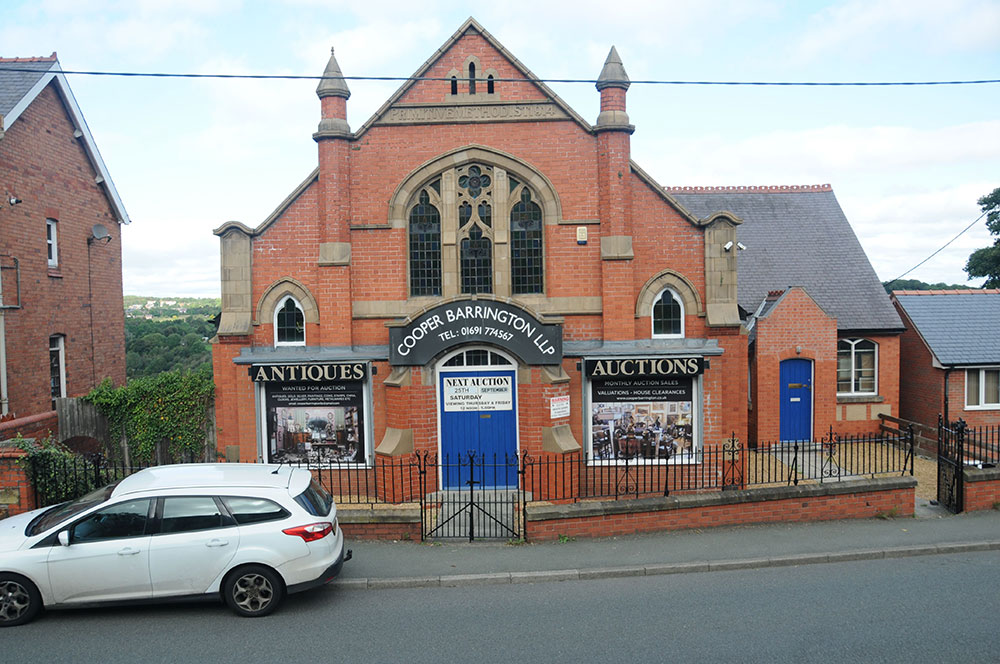
New Methodist Chapel © Jo Danson
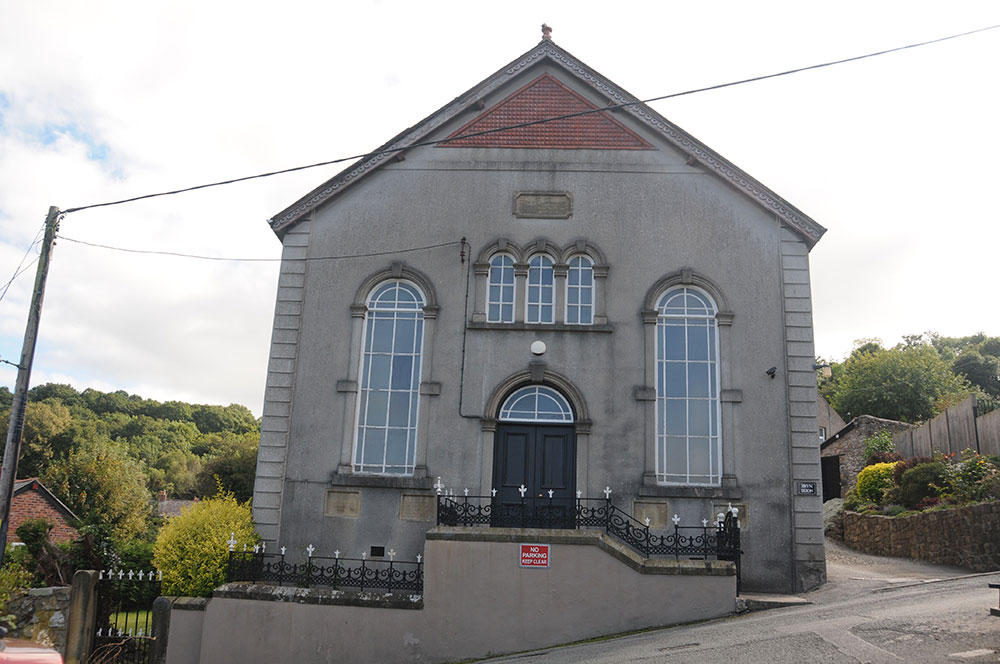
Seion Chapel © Jo Danson
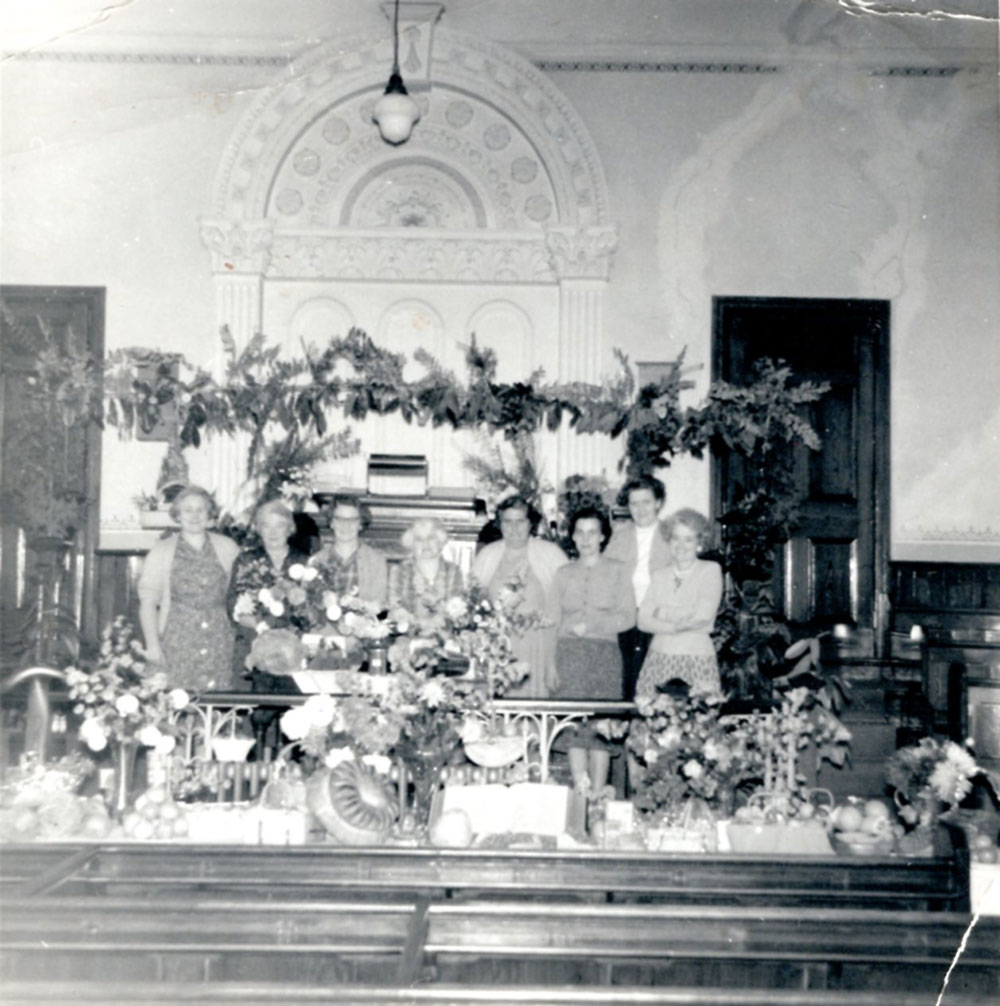
Carmel Chapel © Courtesey of Neil Hayward
11. Fron Male Voice Choir
Fron Male Voice Choir or Cor Meibion Froncysyllte was established after the first Llangollen International Musical Eisteddfod in 1947.
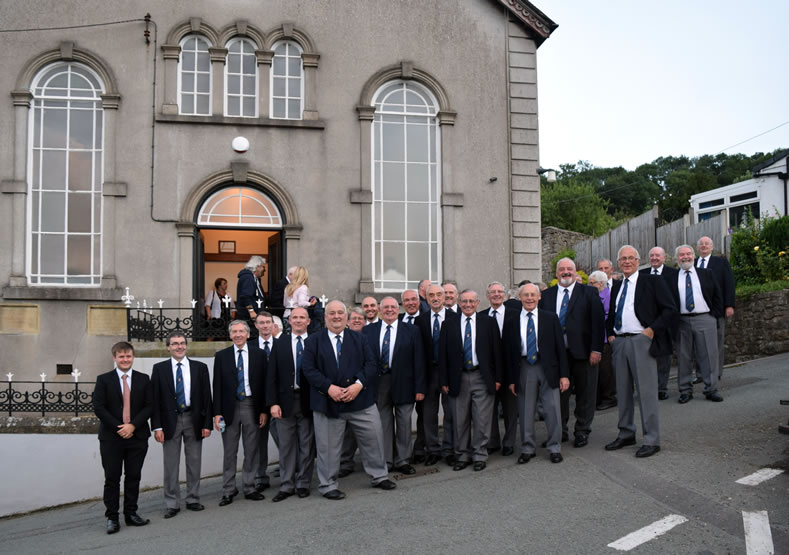
70th anniversary concert at Sion Chapel in Froncysyllte, 2017, where the first meeting of the choir took place © The Fron Male Voice Choir
Listen to…
…Llanfair from the The Fron Male Voice Choir’s latest album Voices of the Valleys Echos
The Choir quickly grew with sixty members including miners, quarrymen and chemical workers. The Choir made its first public appearance at the Armistice Day Service at the cenotaph in the village in 1947 and gave a concert to a capacity audience in the Seion Chapel in December. Competing with other choirs started with the International Eisteddfod in 1948 and by 1954 the Choir was making radio broadcasts from Carmel Chapel. From 1965 the Choir started to tour overseas with a first visit to Germany. Since then the Choir has sung at concerts and competitions all over the world.
The ‘Voices of the Valley’ album released in 2006 reached Number 1 in the Classic Album Charts and their success has continued since then.

Fron Male Voice Choir, 1948 © The Fron Male Voice Choir
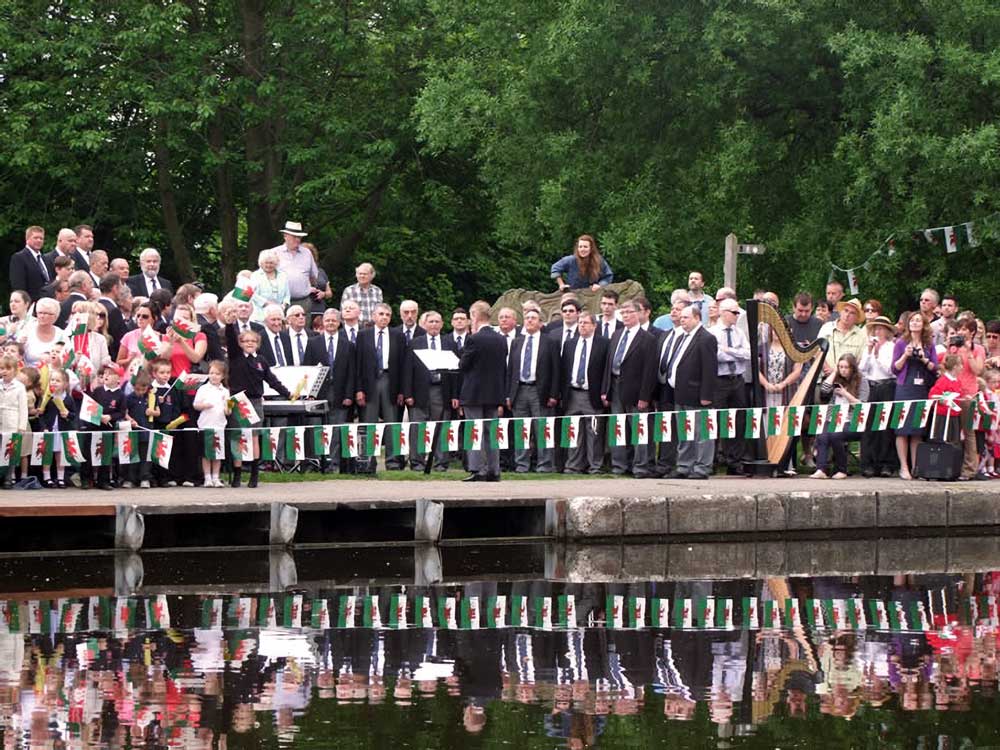
The Choir entertains the crowds at the Pontcysyllte Olympic Torch Ceremony, 30th May, 2012
© The Fron Male Voice Choir
